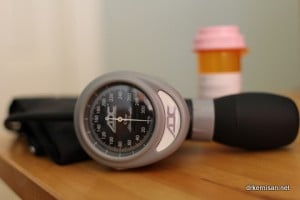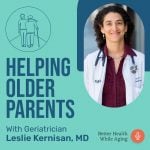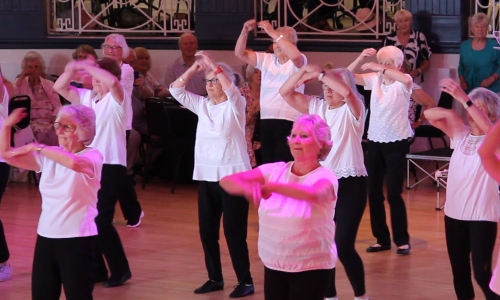

Are you on medication to lower blood pressure? Or are you caring for an older person with hypertension, also known as high blood pressure?
If so, you are probably wondering just what is the right blood pressure (BP) for older adults.
This is a good question, given that guidelines on blood pressure have changed, especially due to the results of the landmark Systolic Blood Pressure Intervention Trial (abbreviated as “SPRINT”).
The SPRINT study first made headlines in part because the findings seemed to contradict expert hypertension guidelines released in December 2013, which for the first time had proposed a higher goal BP ( a systolic BP of less than 150mm mercury) for most adults aged 60 or older.
In particular, SPRINT randomly assigned participants — all of whom were aged 50 or older, and were at high risk for cardiovascular events — to have their systolic blood pressure (that’s the top number) treated to a goal of either 140, or 120. Because the study found that people randomized to a goal of 120 were experiencing better health outcomes, the study was ended early.
For those of us who specialize in optimizing the health of older adults, this was obviously an important research development that could change our medical recommendations for certain older adults.
But what about for you, or for your older relative? Do the SPRINT results mean you should talk to the doctor about changing your BP medications?
Maybe yes, but quite possibly no. In this article, I’ll help you better understand the SPRINT study and results, as well as the side-effects and special considerations for older adults at risk for falls. This way, you’ll better understand how SPRINT’s findings might inform the BP goals that you and your doctors choose to pursue.
Here’s what this post will cover:
- What is currently considered “normal” blood pressure for older adults in their 60s, 70s, 80s
- What the latest blood pressure guidelines recommend
- What to know about the landmark SPRINT blood pressure in older adults trial, including who was included and excluded, and what type of BP medications were used most often
- What the actual likelihood of benefits and harms was within SPRINT, and what you might expect if you are similar to the SPRINT participants
- Why you probably need to make a change in how your blood pressure is measured before considering a SPRINT-style systolic BP goal of 120
- My own approach and how to avoid over-treatment of high blood pressure
I also cover the details of this article in video form on my Youtube channel:
What is considered normal blood pressure for older adults?
Blood pressure is usually recorded as the systolic blood pressure over the diastolic blood pressure. These are measured in millimeters of mercury (“mm Hg”). The systolic measurement (the “top number”) is usually much more important, when it comes to stroke risk and more practical medical considerations. (For more on the basic terminology of blood pressure, see this article.)
As of 2017, the American College of Cardiology and the American Heart Association (ACC/AHA) are defining normal blood pressure and high blood pressure using the same ranges for all adults, regardless of age or gender.
Here is the definition of normal blood pressure (and hypertension) per the ACC/AHA:
| BP Category | Systolic BP | Diastolic BP | |
|---|---|---|---|
| Normal | and | ||
| Elevated | 120–129 mm Hg | and | |
| Hypertension | |||
| Stage 1 | 130–139 mm Hg | or | 80–89 mm Hg |
| Stage 2 | ≥140 mm Hg | or | ≥90 mm Hg |
In short, if you are wondering what is “normal” blood pressure by age: whether a person is in their 60s, 70s, 80s, or 90s, normal blood pressure is considered to be a BP less than 120/80.
Furthermore, the definition of normal blood pressure does not vary between men and women.
Do geriatricians define normal blood pressure differently?
The American Geriatrics Society has not attempted to define normal blood pressure in older adults.
That said, here is the approach that most geriatricians — including myself — take when it comes to blood pressure:
- We first focus on helping an older adult get their systolic blood pressure down to the 140-150mm Hg range.
- After we reach a BP in the 140s, we consider more intensive treatment if it seems feasible and if the older person is not experiencing worrisome side-effects from blood pressure medication.
- We are very alert to the possibility of blood pressure being too low; some older adults feel weak or dizzy when they stand up, especially if their sitting systolic blood pressure is below 120.
For more on how we approach blood pressure treatment, see this article: 6 Steps to Better High Blood Pressure Treatment for Older Adults.
I also recommend learning more about the landmark SPRINT blood pressure trial, which I explain later in this article.
Is there such a thing as low blood pressure?
Yes, this is called hypotension.
Interestingly, the ACC/AHA do not define a lower limit for normal blood pressure. Instead, hypotension is often defined as blood pressure being “lower than expected.”
Generally, a reading of less than 90/60 mm Hg is considered hypotension.
Older adults are also prone to experience something called orthostatic hypotension, which means experiencing a decline >20 mm Hg in systolic BP or >10 mm Hg in diastolic BP, within a few minutes of standing up.
Because orthostatic hypotension can be associated with falls or with passing out, checking BP sitting and standing is one of the things geriatricians do after a fall. (Learn more things to do after a fall here: 8 Things to Have the Doctor Check After an Aging Person Falls.)
What do the newest blood pressure treatment guidelines recommend?
In the US, the American College of Cardiology/American Heart Association (ACC/AHA) guidelines are very prominent. They were last updated in 2017.
For older adults, the ACC/AHA guidelines say:
“Treatment of hypertension with a systolic BP treatment goal of less than 130 mm Hg is recommended for noninstitutionalized ambulatory community-dwelling adults (≥65 years of age) with an average SBP of 130 mm Hg or higher.”
They also say: “For older adults (≥65 years of age) with hypertension and a high burden of comorbidity and limited life expectancy, clinical judgment, patient preference, and a team-based approach to assess risk/benefit is reasonable for decisions regarding intensity of BP lowering and choice of antihypertensive drugs.”
In other words:
- Older adults (who are not in nursing homes) aged 65+ should be treated for high blood pressure if their average systolic BP is higher than 130 mm Hg. The goal should be to get them below 130 mm Hg.
- In those older adults who are chronically ill and may only have a few years left to live, the goal of getting BP below 130 should be reconsidered.
However, in 2017 the American College of Physicians and American Academy of Family Practice issued joint hypertension guidelines endorsing a somewhat higher BP treatment goal for most older adults. In particular, they recommended that:
- Older adults aged 60+ with systolic BP higher than 150mm Hg be treated to get BP below 150.
- Consider further treating older adults at high cardiovascular risk to get to a systolic BP below 140.
- Treatment goals should be based on a periodic discussion of the benefits and harms of specific blood pressure targets
The American Academy of Family Practice subsequently issued an updated guideline in December of 2022, which concluded: “The AAFP recommends primary care clinicians treat adults with hypertension to a standard blood pressure target (less than 140/90 mm Hg)…AAFP also recommends primary care clinicians consider treating adults with hypertension to a lower blood pressure target (less than 135/85 mm Hg) to reduce risk of myocardial infarction.” (This particular guideline did not make a specific recommendation for older adults.)
Note: European Society of Hypertension recommends higher BP treatment goals for adults over age 80
The European Society of Hypertension (ESH) issued updated treatment guidelines in 2023.
Those guidelines do recommend different BP targets based on age, as follows:
- Ages 18-64: target BP
- Ages 65-79: target BP
- Ages 80+: target BP
You can learn more about the differences between the American and European hypertension guidelines here: 2023 ESH Hypertension Guideline Update: Bringing Us Closer Together Across the Pond.
What to know about the SPRINT trial
Who was — and wasn’t — studied in the SPRINT blood pressure trial
The current blood pressure treatment guidelines for older adults are very related to the SPRINT trial results. So it can useful to understand this landmark study.
In particular: do the study results apply to you or your older relative? This is one of the two most important questions to ask yourself when you hear exciting news about clinical research. (The other question to ask is “What’s the “number needed-to-treat,” which corresponds to your odds of actually benefiting; more on that below.)
Why? Because a well-done medical study tells us what health outcomes happened when we applied a certain intervention to a certain group of people. If you aren’t like the people who were studied, then there’s a higher chance you won’t experience the benefits that study participants did.
So who was in SPRINT? Here are the criteria the researchers used to define the study group, and enroll participants.
What the SPRINT participants were like:
- Aged 50 or older, with systolic blood pressure of 130-180mm mercury, and
- At increased risk for cardiovascular disease, which was defined by meeting one of the following conditions:
- Aged 75 or older. Yep, that in of itself puts people at risk.
- A 10-year risk of cardiovascular disease of 15% or greater on the basis of the Framingham risk score. You can check your own Framingham risk score here; you’ll need to know your total cholesterol, HDL cholesterol, and systolic blood pressure.
- Chronic kidney disease, defined by an estimated glomerular filtration rate (eGFR) of 20-60.
- Clinical or subclinical cardiovascular disease other than stroke. This means things like a history of heart attack, bypass surgery, peripheral artery disease, carotid artery stenting or surgery, or any testing considered “positive” for cardiovascular disease. For a full list of criteria, see the published study’s supplemental materials here.
It’s equally important to consider who was excluded from SPRINT. You may have already heard that SPRINT didn’t cover people with diabetes or stroke, but the exclusion list is much longer than that. (See the study appendix for the full detailed list.)
What the SPRINT participants were not like: Older persons with any of the following diagnoses, conditions, or circumstances were not eligible for the study:
- Diabetes
- Past stroke
- Clinical diagnosis of dementia, and/or being on dementia medication
- People residing in a nursing home. (Assisted living was ok.)
- Substance abuse (active or within the past 12 months)
- Symptomatic heart failure within the past 6 months or left ventricular ejection fraction (by any method)
- Polycystic kidney disease or eGFR
- “Significant history of poor compliance with medications or attendance at clinic visits.”
As you can see, quite a lot of common diagnoses and circumstances were grounds for exclusion from the SPRINT study.
Ultimately, 9361 people were enrolled between November 2010 and March 2013. The average age was 68, and 28% of participants were aged 75 or older.
Surprisingly to me, the average systolic blood pressure at baseline was 140, which struck me as better BP control than average older adults. And only 34% of participants had a systolic blood pressure higher than 145 at the start of the study. (For comparison, the CDC reports that only about 1 in 4 adults with hypertension have their blood pressure under control.)
On average, at the start of the study, participants were taking two blood pressure medications.
What did the SPRINT intervention involve?
SPRINT participants were randomly assigned to be treated to a systolic BP goal of either 140, or 120.
Participants were seen once a month for the first three months, and then every 3 months after that.
To treat blood pressure, SPRINT provided all the major classes of BP medication for free, and also allowed clinicians to use other BP medications if they saw fit. Here are the main classes of medication used; I’ve organized them roughly by how commonly they were used (per table S2 of the appendix).
Blood Pressure Medications Used in SPRINT:
- Angiotensin converting enzyme (ACE) inhibitors and angiotensin II receptor blockers (ARBs), e.g. lisinopril, losartan
- Diuretics, e.g. chlorthalidone, hydrochlorothiazide, furosemide, spironolactone
- Calcium-channel blockers, e.g. diltiazem, amlodipine
- Beta-blockers (encouraged for those with coronary artery disease), e.g. metoprolol, atenolol
- Alpha-one blockers, e.g. doxazosin
- Direct vasodilators, e.g. hydralazine, minoxidil
- Alpha-two agonists, e.g. clonidine
Those last three classes of BP medication were used in 10% of people or less, which makes sense as none of them are recommended as first-line medication choices for hypertension, heart conditions, or kidney disease.
What about non-drug methods to manage high blood pressure?
In the scholarly publication, the SPRINT investigators say that “Lifestyle modification was encouraged as part of the management strategy,” but they don’t provide more specifics on what modifications were encouraged or how. So it’s hard to know how any non-drug methods — diet, exercise, salt reduction, stress reduction — might have factored into this study.
Benefits and Harms Observed in SPRINT
SPRINT randomly divided participants into an intensive-treatment group, which aimed for systolic BP less than 120, and a standard-treatment group, which aimed for systolic BP less than 140.
After one year, the average systolic BP among the intensive-treatment group was 121, compared to 136 among the standard-treatment group. The intensive group required an average of 2.8 medications to reach their lower BP goal; the standard group required an average of 1.8 medications.
The follow-up period averaged about three years.
Benefits of intensive BP treatment:
During follow-up, 1.65% per year of people in the intensive-treatment group and 2.19% per year of people in the standard-treatment experienced a significant cardiovascular “outcome event”: a heart attack, a stroke, acute decompensated heart failure, or death from cardiovascular causes.
The study authors calculated that “The numbers needed to treat to prevent a primary outcome event, death from any cause, and death from cardiovascular causes during the median 3.26 years of the trial were 61, 90, and 172, respectively.”
In other words, if you are like the study participants, and if you decide to switch from a systolic BP goal of 140 to a goal of 120, over a few years you’ll have:
- A 1 in 61 (1.6%) chance of avoiding a cardiovascular event
- A 1 in 90 chance (1.1%) chance of avoiding death from any cause
- A 1 in 172 chance (0.6%) chance of avoiding death from cardiovascular causes
(For more on the wonderfully useful statistic the Number Needed to Treat, see this informative NYT article and also the website www.thennt.com.)
Harms of Intensive BP Treatment
The SPRINT investigators were careful to track side-effects and complications. They found that serious adverse events occurred in 38.3% of the intensive-treatment group and in 37.1% of the standard-treatment group.
Adverse events included problems like hypotension (low blood pressure), syncope (passing out), electrolyte problems, declines in kidney function, and injurious falls. Most problems affected 1-7% of participants, with the exception of orthostatic hypotension — which means BP dropping with standing — which affected 16-18% of participants. (Standing BP was checked at baseline, 1, 6, and 12 months and yearly thereafter.)
Although many side-effects were a little more common in the intensively-treated group, injurious falls were equally common in both treatment groups, and affected 7.1% of participants.
This finding is actually consistent with what was reported in a 2014 study of serious falls (e.g. bone-breaking falls) in older people with high blood pressure. In that study, the researchers classified people as being on no BP medication, moderate-intensity BP treatment, or high-intensity BP treatment. Moderate- and high-intensity treatment was linked to a nearly equivalent risk of falling over three years (about 8.5%), whereas 7.1% of older adults on no BP medication had a bad fall.
How Blood Pressure Was Measured in SPRINT
Blood pressure was measured in a very careful way that is quite different from the way patients usually have BP measured by their doctors. Here’s what they did in SPRINT:
- Had people sit down and rest for five minutes before checking BP
- Checked BP three times consecutively, using an automated BP monitor (Omron 907)
- Used the average of those three BP measurements to assess the person’s BP and determine whether medications should be adjusted up or down.
Obviously, this is not the experience that most people have in the doctor’s office, and likely led to lower BP measurements than those taken under usual circumstances.
If you are similar to a SPRINT participant and are thinking of aiming for a lower BP goal, be sure to request that your BP is checked in a similar way. In truth, it’s a much sounder basis for changing a patient’s medications, but it’s not usual care at this time.
And remember: even if you’re like the SPRINT participants — and you might not be — aiming for the lower BP goal likely gives you a 0.5%-1.5% chance of avoiding a bad health outcome. (Whereas you’ll have a very high percent chance of having to take more medication every day.)
If you want to learn more about SPRINT:
SPRINT really was a fascinating research trial, and has led to several interesting sub-analyses. You can learn more about SPRINT results specifically in people over age 75 here: Important Blood Pressure Research: What to Know About SPRINT-Senior.
Do I usually try to get my older patients to “normal” blood pressure?
Given the results of SPRINT and the guidelines, you may be wondering how I personally approach treating high blood pressure in my patients.
In terms of my personal practice: I see a lot of older people who are worried about falls, and a well-done study published in 2014 found that blood pressure treatment was associated with serious — as in, bone breaking — falls. (Read my coverage of this study here.)
I also find that many of my patients are struggling to manage multiple medications, and are at risk for interactions from their medications. For instance, all the medications used in SPRINT have side-effects to watch out for, and many can interact with other medications or chronic diseases.
There is indeed good scientific evidence that for those older adults who have a systolic BP in the 160s or higher, getting them down to a systolic in the 140s does reduce the chance of strokes and other serious cardiovascular diseases. (See here and here.) So it’s certainly important to identify serious hypertension in older adults, and treat it if possible.
But given the relatively small absolute benefit of aiming for a systolic blood pressure of 120, I have found that for most of my patients, aiming for a systolic BP in the 140s is reasonable.
Now, you are likely still wondering what’s the right blood pressure goal for you or your older relative. I can’t tell you for sure for your particular situation. But here’s more information on why it’s worth being careful about over-treating high blood pressure, and why I agreed with the December 2013 guidelines recommending a systolic BP goal of 150 for most seniors.
Why Older Adults Should Watch Out for Over-Treatment of High Blood Pressure
In my experience, many older adults are taking more BP medication than they need, meaning they’ve reached a point at which the risks and burdens outweigh the benefits (compared with less aggressive treatment of high blood pressure).
This can cause falls or dizziness due to orthostatic hypotension, and one of the most common medication changes I implement as a geriatrician is the cutting back of blood pressure medications.
How can you know if you might be dealing with over-treatment of high blood pressure? Here are the steps I recommend:
1.Check the older person’s blood pressure, and know what his/her systolic BP is. The best way to do this is to use a high-quality BP machine, and to have the BP checked at the same time of day, for 3-7 days in a row. If possible, check twice a day instead of once a day. (For more on checking BP at home, see this post.)
- Since blood pressure is constantly changing a bit within the body, a series of measurements gives a more accurate idea of where a person’s BP usually is.
- Home-based BP checks have been shown to correlate better with a person’s true BP than occasional office-based BP checks.
- If there have been any falls, or if systolic BP is less than 120, consider checking BP both sitting and standing. If BP is dropping a lot when the person stands (which is a sign of orthostatic hypotension), you’ll want to ask the doctor to address this.
2. Plan to talk to the older person’s doctor about reviewing the blood pressure treatment plan. This is especially important if:
- Sitting systolic BP is less than 130mm Hg and you’re noticing a drop of 20 mm Hg or more when the older person stands.
- Sitting systolic BP is less than 120 mm Hg and you’ve been worried about falls.
- Sitting systolic BP is less than 110 mm Hg.
- Sitting systolic BP is often over 150 mm Hg (in which case, we might be dealing with under-treatment of hypertension).
For more on how to figure out blood pressure treatment for people in their 60s, 70s, 80s, or 90s, see here: 6 Steps to Better High Blood Pressure Treatment for Older Adults.
[This article was first published in 2015. It has been regularly reviewed and updated, most recently in January 2025.]




